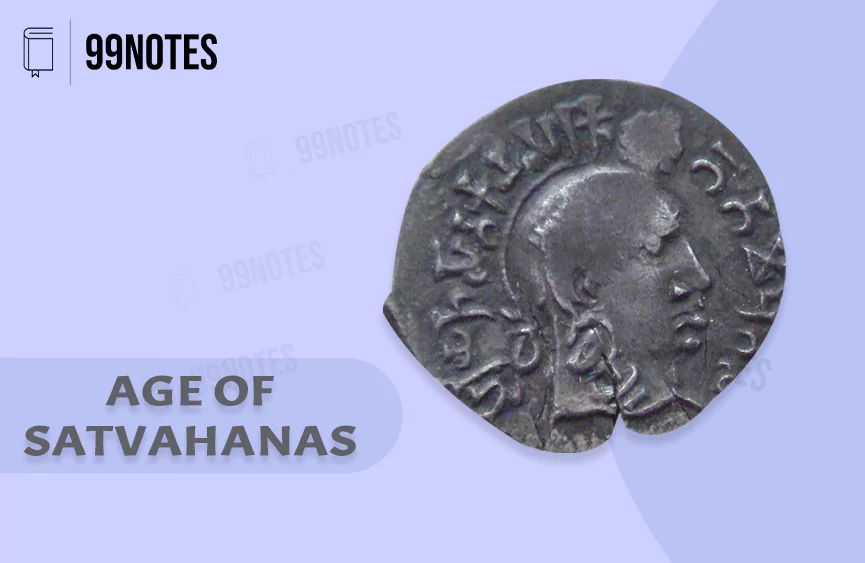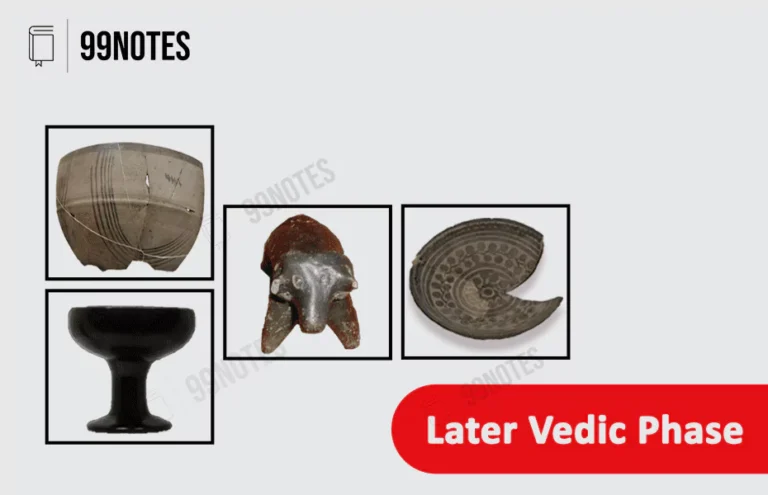Satavahana Dynasty: History, Rulers, Administration, Society, Art & Architecture- UPSC Notes
Age of Satvahanas
- Satvahanas succeeded the Mauryan Empire in Deccan and Central India. They are considered to be identical to Andhras mentioned in Puranas. However, the word ‘Andhra’ does not appear in the Satvahana inscriptions.
- The term “Satvahana” is a Prakrit word, which means “Driven by seven”, which implies Sun God’s chariot that seven horses drive according to Hindu mythology.
Political History of Satvahanas
- Simuka (100-70 BCE) was the first king of the Satvahana dynasty.
- The Puranas and Geography of Ptolemy indicate that the Satavahana capital was located at Pratisthana (Paithan in central Deccan).
- They set up their power in Upper Godavari valley in Maharashtra; gradually, they extended their control over Karnataka and Andhra. Shakas were the greatest competitors who ruled the Upper Deccan and western India.
- SriSatkarni I was the first powerful ruler of the dynasty.
- He has been lauded as the Lord of the Deccan (Dakshinapathapati) in Queen Naganika’s inscription at Naneghat(Maharashtra).
- The Hathigumpha inscription of the Kalinga king Kharavela mentions a king named “Satakani” or “Satakamini”, who had to defend his territory against a Kharavela’s threat to a city.
- Sarkari II (50BCE-25BCE) captured Malwa from Shungas and took control of Sanchi. The Torana gateways at Sanchi were decorated by Satakarni II, which we know from an inscription at Sanchi Stupa.
- He also faced a new threat from Shakas in the west.
- Satkarni II was followed by weak rulers who lost some of their territories to Shakas in the north and west.
- Gautamiputra satkarni (106-130 AD) won back the lost territories. He called himself ‘Ekabrahmana’ (the unique Brahamana).
- We learn about his achievements and personality from the Nasik prasasti, which was caused to be engraved by his mother, Gautami Balasri, during the reign of Vashisthiputra Pulumavi (130-154 AD).
- He defeated the Shakas and many Kshatriya rulers. He claims to have destroyed the Kshatriya lineage to which his adversary Nahapana (a Shaka king) belonged.
- It seems his empire extended from Malwa in the north to Karnataka in the south, according to the Nashik Prashasti.
- Satvahana Conflict with Shakas over Malwa and Konkan:
- Satkarni II initially captured Malwa from Shungas. However, the later rulers lost it to Shakas. Gautamiputra satkarni eventually defeated the Shakas recovering all the territories back.
- Vashisthiputra Pulumavi (130-154 AD) married Shaka ruler Rudradaman I’s daughter.
- The Shakas resumed their conflict with Satavahans to control the Konkan coast and Malwa. Rudradaman I (130-150 AD), the Shaka ruler of Kathiawar, defeated the Satvahanas twice but did not destroy them because of matrimonial relations.
- Yajna Sri Satkarni (165-194 AD), one of the later kings, recovered north Konkan and Malwa from Shakas.
- The end of the Satavahana rule in Deccan is likely to have occurred in 225 CE. This power vacuum paved the way for the rise of the Vakatakas in the Deccan, Kadambas in Mysore, Abhiras in Maharashtra and Ikshvakus in Andhra.
| Satvahana Kings | The gist of their deeds |
| Sri Satkarni I (27 BCE- 17 BCE) | Nanaghat inscription describes him as Dakshinpathpati (The Lord of “Southern Road”). He defended his land against King Kharvela of Kalinga |
| Satkarni II BCE-20CE) | Captured Malwa from Shunga. He constructed Torana gateways at Sanchi, which we know from a Brahmi inscription at Sanchi. |
| Hala-I (20 CE-24 CE) | Composed Gatha-Saptsati in Maharashtri Prakrit. |
| Gautamiputra Satkarni (106-130 AD) | Revived Satavahan power. His achievements are recorded in Nasik Prasasthi by his mother, Gautami Balasari, where he is referred to as Eka-Brahman. |
| Vashisthiputra Pulumavi (130-154 AD) | He expanded the Satavahana Empire’s borders. Married a daughter of Saka King Rudradaman |
| Yajna Sri Satkarni (165-194 AD) | Last great ruler of the Satavahana dynasty. His coins figure ships, indicating naval power. |
Material Culture and Economy
- The material culture of the Deccan under the Satavahanas was a combination of local elements and northern ingredients. Through contacts with the north, the people of Deccan learnt the use of coins, burnt bricks, ring wells, the art of writing etc.
- The people of the Deccan were fairly familiar with iron and agriculture.
- The people of Deccan were aware of the art of paddy transplantation. The area between the Krishna and the Godavari formed a great rice bowl in the first two centuries. They also cultivated Cotton.
- The Satavahanas most likely made use of the abundant mineral resources of the Deccan, including gold from the Kolar fields and iron ores from Karimnagar and Warangal.
- They mostly issued coins of lead, which is found in the Deccan and coins of copper and bronze.
Social organization
- The Satvahana rulers embraced the Brahmanical norms as the state’s ideology. They performed Vedic sacrifices like Asvamedha, Vajapeya and Rajasuya, all being symbolic of an undisputed rule.
- Gautamiputra Satakarni was glorified as the only brahmana (Eka brahmana) who stopped the admixture among the four varnas.
- The Shaka rulers were absorbed as Kshatriyas in the Brahmanical society with intermarriage between the Shakas and the Satavahanas. However, it is unclear if the ordinary Shaka kinsmen were accepted as Kshatriyas too.
- Indigenous tribes were converted by Buddhist monks who were given land grants to settle in western Deccan.
- The Gandhikas (the perfumers) are repeatedly mentioned as donors to the Buddhist cause.
- Women were given an important position in society. In the Satavahana realm, the importance of queens, e.g. Nayanika and Gautami Balasri, was recognized. Nayanika served as a queen regent when her son was a minor. Even coins were issued with her name inscribed on one side, with her spouse Satakarni’s name on the other.
- A matronymic society: It was customary for the king to be named after his mother.
- However, succession to the throne is always passed to the male member, still making it a Patrilineal society.
Polity and Administration
- The Satvahanas rulers strove for the royal ideals set enshrined in the Dharmasutras. The king was represented as an upholder of dharma, as was the practice after the Ashokan times.
- Administration: The Satavahans retained some of the administrative units found in Ashokan times. Their district was referred to as Ahara, and their officials as Amatyas and Mahamatras.
| Officials | Responsibility |
| Amatya | The Highest position in the administration |
| Senapati | He was a feudatory, appointed both as a military chief and provincial governor. |
| Gaulmika | A rural administrator similar to Mauryan Gaulmika; A head of the military regiment consisting of nine chariots, 25 Horses and 45-foot soldiers. |
- Introduction of Feudal polity: We notice certain military and feudal elements in the Satvahana administration.
- The Senapati was appointed provincial governor. It may have been done to keep the tribal people in the Deccan under control.
- The military camps and settlements (Kataka and Skandhavaras) also served as administrative centres as long as the king was there.
- Gaulmika, the head of a military regiment, was responsible for the administration of rural areas.
- Feudatories: The granted villages became Independent Islands within the Satavahan kingdom. The Satavahana kingdom had three kinds of feudatories.The king (Raja) formed the highest grade; Mahabhoja and Senapati followed him.
Religion
- Religious donations: One of the practices started by Satavahana rulers in the 1st century BCE was granting tax-free villages to brahmana and Buddhist sangha. This practice became much more widespread under the Gupta rulers.
- The Satavahana rulers were Brahmins, and from the very beginning, the kings and queens performed Vedic sacrifices such as Ashvamedha, vajapeya etc.
- They also worshipped many Vaishnav gods such as Krishna, Vasudev and others.
- They also paid a liberal sacrificial fee to Brahmanas.
- However, they also promoted Buddhism by granting land to monks, and Mahayana Buddhism commanded a considerable following among the artisan class. For example, Nagarjunakonda and Amaravati became important centres of Buddhism during Satvahana Rule.
Architectures and Language
- In the Satavahana phase, Many Buddhist temples (chaitya) and monasteries (viharas) were cut out of solid rock in north-western Deccan. For example, Karle chaitya in western Deccan.
- Nagarjunakonda and Amaravati are famous for large Buddhist stupas that depict various scenes from the life of the Buddha.
- Language: The official language of Satvahans was Prakrit, and the script was Brahmi, as was in the case of Ashoka. Prakrit text Gathasaptasati is attributed to Satavahana king Hala.
Inscriptions:
- At Nasik, we find three viharas which contain inscriptions of Nanighata, Nahapana and Gautamiputra.
- There are four inscriptions in Nashik Cave No. 3 which talk about Gautamiputra Satkarni’s reign, which includes the Gautami Balsari inscription. The Gautami Balsari inscription is also known as Nashik Prashasti.
- Of these, the following inscriptions are important:
| Nani-Ghat Inscription | It is inscribed by Nanika (the wife of Satkarni) – It tells about the lineage of the Satkarnis.It mentions the Vedic deities such as Indra, Surya, Chandra, Kuber, Yama and Varuna, as well as Krishna Vasudeva. Thus, it forms a transition from Vedic tradition to modern-day Hinduism. |
| Gautami Balsari Inscription/ Nashik Prashasti | It was inscribed by the mother of Gautamiputra, Gautami Balsari, who glorifies her son with various titles.He is addressed as the Vindhyaraja (Lord of Vindhyas).He is said to have restored the pride of Dvijas (born twice, i.e. upper Varnas) and stopped the contamination of four Varnas.It was inscribed during the reign of Vashishtiputra. |
| Nahapana Inscription: | Nahapana Inscription was installed in Nashik cave No. 10 by Ushavadata, the Kshatrapa of Shaka king Nahapana.It notes all the donations, such as land, cows and food, given to Brahmans by Ushavadata, including the construction of the shelter. |
Explore additional significant articles on Ancient Indian History listed in the table below:
| Stone Age | Harappan Civilisation |
| Vedic Period | The Mahajanapadas |
| Decan States of Ancient India | Understanding Mauryan Society |
| The Gupta Empire | Indian During Its Golden Age |



![Sangam Age: Literature, Map, &Amp; Dynasties [Upsc Exam Notes] | Updated November 21, 2024 Sangam Age: Literature, Map, &Amp; Dynasties [Upsc Exam Notes]](https://99notes.in/wp-content/uploads/2023/04/megalith-sangam-age-99notes-upsc-768x495.webp)



![Complete Vedic Period Upsc Notes [1500 Bce-500 Bce] | Updated November 21, 2024 Complete Vedic Period Upsc Notes [1500 Bce-500 Bce]](https://99notes.in/wp-content/uploads/2023/04/vedic-culture-99notes-upsc-1-768x495.webp)